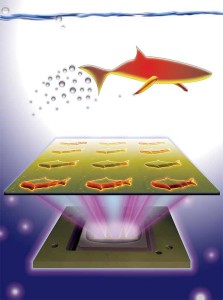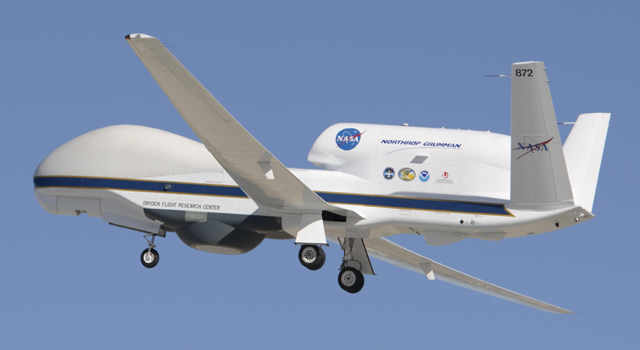Daily Business Report-Aug. 26, 2015
NASA’s Global Hawk UAV made by Northrop Grumman
Global Hawk UAV Put into Service
To Improve Hurricane Forecasts
One of NASA’s Global Hawk unmanned aircraft has arrived at Wallops Island, Va., where it will begin a new mission to improve hurricane forecasts.
The vehicle, which is manufactured by Northrop Grumman, landed Aug. 22 at NASA’s Wallops Flight Facility, where it will kick off the Sensing Hazards with Operational Unmanned Technology, or SHOUT, program for the National Oceanic and Atmospheric Administration.
SHOUT builds off earlier work led by NASA and will move the Global Hawk closer to being put into operational use as a weather forecast observation tool, according to NOAA.
“We’re flying the Global Hawk above hurricanes and other severe storms to refine it as a new, powerful tool with the potential to contribute to better forecasts of where hurricanes go and how intense they are,” says Robbie Hood, director of NOAA’s Unmanned Aircraft System Program. “The mission is part of NOAA’s work to improve our nation’s preparedness and resilience to hurricanes and other severe storms.”
Through the end of September, NOAA, NASA and other partners will fly the Global Hawk over the Atlantic Ocean to collect data on temperature, moisture, wind speed and direction. That data will feed into the National Weather Service forecast models used by the National Hurricane Center.
“The Global Hawk allows us to stay over these weather patterns a greater amount of time than manned aircraft,” says Gary Wick, NOAA’s lead scientist for the mission. “It provides us with an observing tool that has the endurance of a satellite but provides finer resolution data and the precision of an aircraft.”
The Global Hawk — the sixth one ever built — is equipped with various instruments, including dropsondes, a radar that can measure precipitation and wind speed, a microwave sounder that takes vertical profiles of temperature and humidity, and a NASA lightning instrument that measures the electric field of thunderstorms.
— Association for Unmanned Vehicle Systems International
______________________________________
UCSD Researchers Develop ‘Microfish’
Capable of Removing and Sensing Toxins

Nanoengineers at the UC San Diego used an innovative 3D printing technology they developed to manufacture multipurpose fish-shaped microrobots — called microfish — that swim around efficiently in liquids and are capable of removing and sensing toxins.
The technique used to fabricate the microfish provides numerous improvements over other methods traditionally employed to create microrobots with various locomotion mechanisms, such as microjet engines, microdrillers and microrockets. Most of these microrobots are incapable of performing more sophisticated tasks because they feature simple designs — such as spherical or cylindrical structures — and are made of homogeneous inorganic materials. In this new study, researchers demonstrated a simple way to create more complex microrobots.
The research, led by Professors Shaochen Chen and Joseph Wang of the NanoEngineering Department at the UC San Diego, was published in the Aug. 12 issue of the journal Advanced Materials.
By combining Chen’s 3D printing technology with Wang’s expertise in microrobots, the team was able to custom-build microfish that can do more than simply swim around when placed in a solution containing hydrogen peroxide. Nanoengineers were able to easily add functional nanoparticles into certain parts of the microfish bodies. They installed platinum nanoparticles in the tails, which react with hydrogen peroxide to propel the microfish forward, and magnetic iron oxide nanoparticles in the heads, which allowed them to be steered with magnets.

Poway Apartments Sold for $41.15 Million
The Summerlyn Apartments, a 193-unit complex at 13409 Midland Road in Poway, has been sold for $41.15 million to an affiliate of Pacific Urban Residential. The seller was Fairfield Township LLC.
Summerlyn has 10, two-story buildings and a newly upgraded fitness center, 24-hour card operated laundry rooms, pool, spa and wading pool, tennis court, dog park, picnic areas with gas barbecues, and a business center.
The average floor plan is 803 square feet, and the average rent is $1,480 per unit.
Fairfield had spent more than $2.9 million on capital improvements since it acquired the property in 2007.
CBRE represented the seller in the sale.
Illumina Teams With Irish Cattlemen
To Improve Breeding of Livestock
City News Service
San Diego-based Illumina Inc. reported Tuesday that it’s teaming up with cattlemen in Ireland to improve the breeding of livestock.
The Irish Cattle Breeding Federation, a nonprofit charged with providing cattle breeding information services to the Irish dairy and beef industries, chose Illumina as its technology partner for their Beef Data and Genomics Program. The program, which will run until 2020, is designed to improve the genetics of the national herd by identifying DNA variants.
Ranchers traditionally eyeball the members of their herd for desirable traits, but Illumina said the genomics program will provide them with faster and more accurate data. The company will provide the equipment and technology needed for the program.
“The ultimate goal is to reach a point where every animal born will be genotyped,” said Iain MacLaren-Lee, the company’s market development manager for agrigenomics.
“In Ireland that would be two million animals per year,” MacLaren-Lee said. “It’s the ambition of ICBF and the Irish Department of Agriculture to be the first country in the world to genotype the entire national herd.”
He said the program could lead to the routine adoption of genotyping in cattle farming.
According to MacLaren-Lee, most previous genetic sampling projects have involved tens of thousands of animals, with a few going over a couple of hundred thousand.
Participating farmers will be required to genotype 15 percent of their cows by submitting samples to the ICBF. The organization hopes to record one million animals within two years.
Water Authority Launches Mobile
App to Report and Fix Water Waste

The San Diego County Water Authority on Tuesday launched a smartphone app that enables users across the region to report water waste such as broken sprinklers, excess irrigation and potential violations of local water-use rules with the option of including a photo or video.
The Water Authority developed the app — “When in Drought, Report Waste” — in partnership with its 24 member water agencies to help inform property owners, meet state water-use reduction targets and avoid state fines. The Water Authority’s member agencies are responsible for responding to water waste reports generated for their service areas.
The app is free and available for both iPhone and Android devices through their respective app stores. There also is a link to the app on
the agency’s website: www.sdcwa.org.
“Residents and businesses across San Diego County are doing a great job saving water,” said Mark Weston, chair of the Water Authority’s Board of Directors. “Often property owners are unaware of problems with their irrigation systems. Now when residents see water-waste issues in the community, they can use their smartphones to help correct the problem quickly.”
After downloading the app, users can report waste by either entering an address, or using the geolocation feature to pinpoint the location of the problem. Users then select from a list of common problems and have the option to enter more detailed information. Users also may include a video or photo of the problem.
The app includes other features such as links to online water conservation resources and rebates, a local water agency map and locator, and additional information about local and state restrictions. It can be used across all areas of the county served by the Water Authority’s member agencies.
SDG&E Sets Renewable Energy Record
City News Service
San Diego Gas & Electric announced Tuesday that it produced 1,042 megawatts of renewable electricity on its power grid one day last week, the most ever.
The amount generated last Wednesday at 12:51 p.m. didn’t include energy produced by 61,000 SDG&E rooftop solar customers.
“A combination of bright sunshine and strong wind conditions in the San Diego and Imperial Valley helped to generate the record-setting amount of green energy for our customers,” said Scott Drury, chief energy supply officer for SDG&E. “We are proud to have delivered 33 percent renewable power over the last twelve months — the first utility in California to do so.”
Stephanie Donovan of SDG&E told City News Service that the utility usually produces around 900 to 1,000 megawatts of renewable energy in a given day, but production fluctuates throughout the day based on prevailing weather conditions.
The California Independent System Operator also reported a statewide record for renewable generation of 6,341 megawatts on the same day about an hour after SDG&E’s peak. That eclipsed the previous all-time statewide peak of 6,330 megawatts set one week earlier.
FDA Approves Dexcom System
For Continuous Glucose Monitoring
Dexcom Inc. announced Tuesday that the U.S. Food and Drug Administration has approved its Dexcom G5 Mobile Continuous Glucose Monitoring System for diabetes sufferers that sends glucose data directly to a smartphone. The system frees users from the need to carry a separate receiver.
The new transmitter securely sends vital glucose information directly to an app on iOS-enabled devices for real-time diabetes management. Android applications will follow early next year.
“Dexcom is rapidly advancing technology for continuous glucose monitoring devices to improve diabetes management,” said Kevin Sayer, president and CEO of San Diego-based Dexcom.
The G5 Mobile system is anticipated to begin shipping in late September.
Sequenom and UCSD Collaborate
On Liquid Biopsy Assay Study
Sequenom said today that it is collaborating with the University of California, San Diego in a clinical research study of its next-generation sequencing-based circulating tumor DNA assay.
Under the collaboration, UC San Diego’s Moores Cancer Center will test the utility of the assay to profile ctDNA in blood to monitor cancer patients and assist in therapy selection.
Sequenom first announced it intended to develop a liquid biopsy assay in January and at the time said it had partnered with UCSD, but did not provide details of the assay.
The ctDNA assay will initially be designed for research use only in solid tumors and will cover over 100 cancer-related genes that are associated with a US Food and Drug Administration-approved treatment, included in professional society guidelines, linked to targeted therapies currently in clinical trials, or part of well-documented cancer pathways. The initial focus of the test will be on late-stage cancers where tissue biopsies are not available or are too risky to obtain.
“The ability to match patients to a growing list of treatments and to monitor their response by a simple blood draw promises to make a significant difference in the way we treat cancer patients at UC San Diego,” Razelle Kurzrock, director of the Center for Personalized Cancer Therapy & Clinical Trials Office at UCSD, said in a statement.

San Diego’s Traffic Congestion
Lower Among Major Metros
Times of San Diego
San Diego drivers frequently complain about traffic, but a new report finds congestion to be the lowest among the nation’s 15 largest metro areas.
Washington, D.C., ranked first and Los Angeles second in the 2015 Urban Mobility Scorecard, but San Diego was 15th among metro areas over 3 million population, and 43rd overall, in the same congestion league as Albany-Schenectady NY.
San Diego commuters wasted an average of 42 hours a year in traffic, but that was half of the 82 hours wasted by drivers in the nation’s capital. Other cities with high congestion were Los Angeles at 80 hours, San Francisco at 78 hours, New York at 74 hours and San Jose at 67 hours.
The scorecard, prepared by the Texas A&M Transportation Institute and the data analytics company INRIX, said traffic congestion has become so bad in major urban areas that drivers frequently have to plan more than twice as much travel time as they would need to arrive on time in light traffic.
“Our growing traffic problem is too massive for any one entity to handle — state and local agencies can’t do it alone,” says Tim Lomax, a report co-author and a regents fellow at the transportation institute.
“Businesses can give their employees more flexibility in where, when and how they work, individual workers can adjust their commuting patterns, and we can have better thinking when it comes to long-term land use planning. This problem calls for a classic ‘all-hands-on-deck’ approach.”
Nationwide traffic congestion wastes nearly 7 billion hours of time, the report found.

